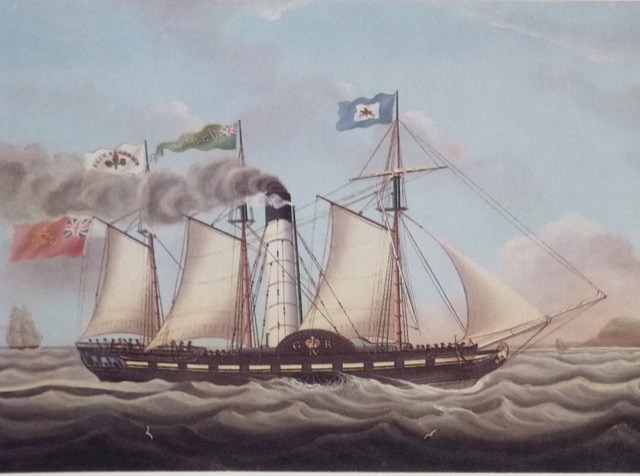
Jump to St George Steam Packet Company.
St Patrick 1831
Wooden paddle steamer b 1825 Clarke and Nickson, Liverpool
203 tons; 130' x 22'; engines b Fawcett & Preston, Liverpool
Owned St George Steam Packet Company
Passage Cork to Waterford
Struck sand Bank near Hook Tower 24 Nov 1831.
All crew and passengers saved
[from British Press - Thursday 18 August 1825]:
This morning, at half-past eleven, a beautiful
new steam-packet, to be called the St. Patrick, will be launched from
the building yard of Messrs. Clarke and Nickson. She belongs to the
St. George Steam-packet Company, and is intended to ply between
Liverpool and Dublin.
LOSS OF THE ST. PATRICK STEAMER.
Information was received in this city on Monday, of the loss of the
St. Patrick steamer (late of Bristol,) on Friday evening last [24 November
1831], about six o'clock, off the Hook Tower, Waterford, in a dense fog. Her
bottom is said to be beat out. The crew and passengers were saved. She was
bound from Cork to Waterford, and it was intended to put her on the line from
the latter port to Liverpool. Her usual Captain (Goff) was not on board at the
time of the accident.
This vessel was not refloated - a new St Patrick was ordered - see
below.
Note that divers reported in 1989 finding brass pieces on the seabed
in 9-12ft near 52°9' N, 6°55' W. This is close to the reported
location of this wreck, although several other vessels are also reported
to have been lost in this area.
Image of PS St Patrick arriving off Cork taken from
painting by Myles Walters in 1827

This first St. Patrick was sold to Portuguese interests (Joao
Baptista Angelo da Costa and Co.) in
1824 and provided a service betwen Lisbon and Oporto named
Restaurador Lusitano.
When sold to Portugal in 1824,
another St. Patrick (details as above) was built in Liverpool in 1825 to replace it.
The St. George Company added two more vessels
soon afterwards, the Lee on the Cork to Liverpool route, and the Severn on
the Cork to Bristol route. In 1825 the company H.Q. moved to Warren's Place, Cork,
and in 1831 moved again to Penrose Quay in Cork.
Advertisement by St. George Steam-Packet company of services [from
Dublin Mercantile Advertiser, 13 March 1826]:
The ST. GEORGE and EMERALD ISLE, between Liverpool, Dublin, and
Bristol.
The LORD BLAYNEY, between Liverpool and Dublin.
The LEE, between Liverpool and Cork.
The SUIR, between Liverpool and Waterford.
The ST. DAVID, between Liverpool and Newry.
The PRINCE LLEWELYN, between Liverpool, Beaumaris and the Menai
Bridge and Bangor.
The KINGSTOWN between Menai Bridge and Dublin (occasionally)
The SATELLITE, between Liverpool and Bagillt.
The SEVERN, between Cork and Bristol.
The following Vessels are also in a state of
great forwardness;
The ERIN, intended to ply between Dublin and Cork.
The AVON, between Dublin and Bristol.
The CORK PACKET, between Liverpool and Cork.
The LORD RODEN, between Liverpool and Dundalk.
Because of the loss of their second St. Patrick near Waterford (as described above), a third St. Patrick was built at Liverpool in 1833 to replace that one. The company had an increasing role in Irish Sea trade.
The company was reorganised, with additional funding, in 1843 and renamed City of Cork Steam Ship Company. The house flag was retained (a St. George Cross) which was very similar to that used by Royal Navy vessels with a flag officer aboard - in 1882, a blue star was added to the middle of the red cross to create a distinction.
The ownership of steamers was often complex, but here is a list of wrecks of those vessels involved with the St. George Steam Packet Company: Earl of Roden 1828; St. George 1830; Erin 1833; Lord Blayney 1833; Superb 1835; St. Patrick 1838; St. David 1839; Herald 1839; Sirius 1847[see above]; Mermaid 1845; Victory 1853.